Welcome to another edition of Spider Friday: You can see previous editions of Spider Friday by following
this link.
I want to do something different this Friday. I'm going to take a break from introducing the latest esoteric spider for one week to take you on a photoessay of some spiders in my neck of the woods, starting with my favorite spider: my tarantula Emily.
All the pictures you'll see here were taken by yours truly. If you want to use them for any purpose, feel free--an attribution is nice, but not required. I was actually amazed at how well some of my close-up shots turned out--maybe I should try being an amateur nature photographer :-)
Spiders below!
I'd like to start out by introducing the only female that currently shares my bedroom with me. Her name is Emily, and she's a Mexican Red Knee (and please, no Rush Limbaugh jokes), scientific name
B. emilia. I've had Emily ever since she was a spiderling.

Emily is 2 years old, and if I treat her right, she should last at least 5 more years. Spiders might be cheap and easy to care for, but they aren't throwaway pets--they require many years of commitment. Most people would freak out about having a spider on their bed--I think it makes for a nice photo-op.
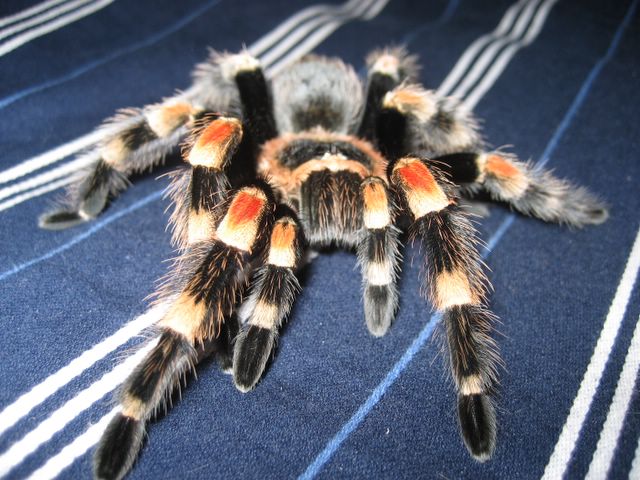
If you're thinking about getting a tarantula for the first time, either for yourself or for a child, I highly recommend the Mexican Red Knee. Most tarantulas require pretty strict management of humidity and temperature, but the Mexican Red-Knee comes from a more inhospitable climate than do most Central and South American species, so they don't require the same type of level of care. And they're very attractive spiders too, as Emily demonstrates:

In the preceding picture--especially if you click for the larger version--you can clearly see the twin tarsi on each of Emily's feet, and these give her the very strong gripping power she displays here--climbing smooth, painted ceramic with no problem. Emily is a very good climber--she can climb sheer glass with not too many problems.
I don't take Emily out too much--it's stressful for the spider, and having her walk on me makes my hands itch for days for whatever reason. She spends the vast bulk of her time in her terrarium:
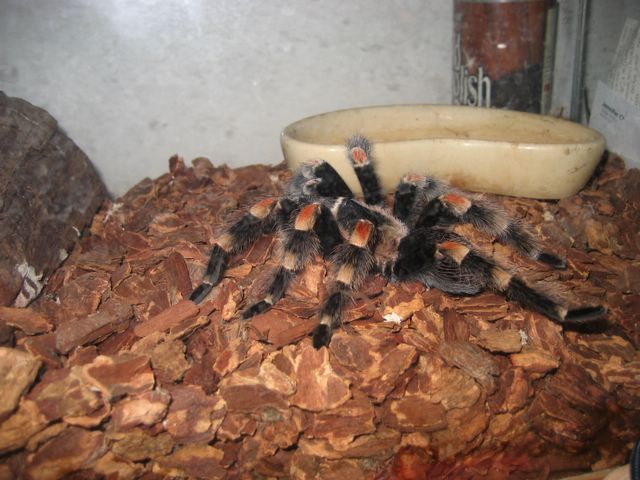
This is what it looks like if you're a cricket inside the terrarium. And if you are, this is probably the last thing you'll see:

When I do take Emily out, though, sometimes I like to pretend I'm auditioning for the sequel to Arachnophobia:

Emily happened to molt when I was at YearlyKos. Spiders have exoskeletons, and they have to shed them to be able to grow. What's left over is a perfectly in-tact replica of the spider. Spiders molt very frequently as spiderlings because of their growth rate, but then their rate of molting slows. Emily now molts once every 8 months or so. Here's a shot of Emily's molted exoskeleton:
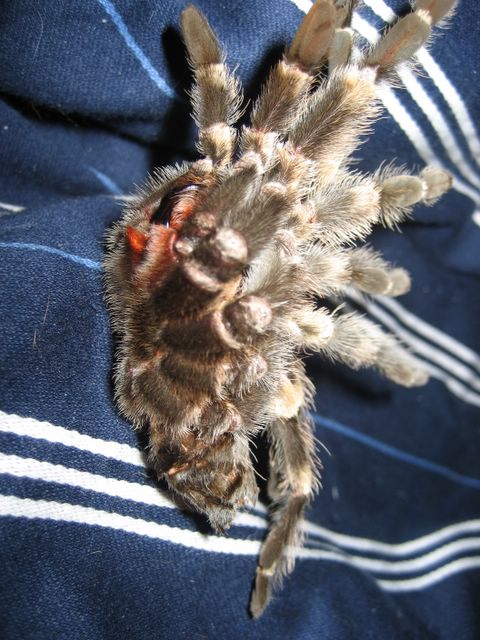
Tarantulas don't just shed their exoskeleton, however--they also shed some internal stuff, including their sex organs and book-lungs. The white speck on this close-up of the molted abdomen is actually an organ, if I'm not mistaken:

So, that's Emily. Let's move on to some other spiders in the neighborhood. Here is a grass spider, Agelenopsis sp.: This one is very small--it's only a spiderling at this point.

We also have a few orbweb weavers around. I took a couple of hornworms off the tomato plants and fed them to a barn spider. The spider wrapped them up together and started munching away.

But you know what I have a lot of in the surrounding area? Black widows. A ton of them. They come out at night to weave their webs, and I go out with my camera and shoot close-ups. To get some of these shots I'm about to post with the type of camera that I have, I have to literally get the lens within an inch of the spider--so this endeavor really isn't for the timid or arachnophobic, especially since these things can obviously pack a bunch. So below, I present to you some black widow closeups. Captions are below the images. To get the full effect, click on each image for the full-size version.

This is an immature black widow, with a cobweb spider down in the lower right. They seemed not to mind each other's company.
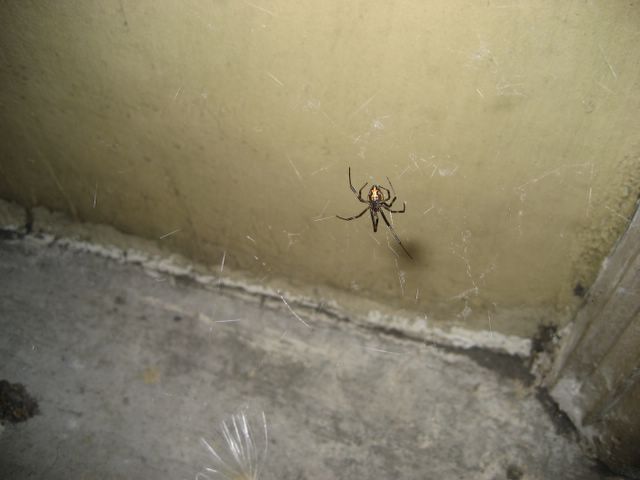
Another immature black widow.

An older, but still immature, black widow. Notice the mottled appearance, the alternating colors on the legs, and the molt skin just to the left of the spider.

Fully adult L. hesperus. As I was getting the closeup shot, a cricket happened to make the last mistake it will ever make by jumping straight up into the web.

The actual moment of the bite.
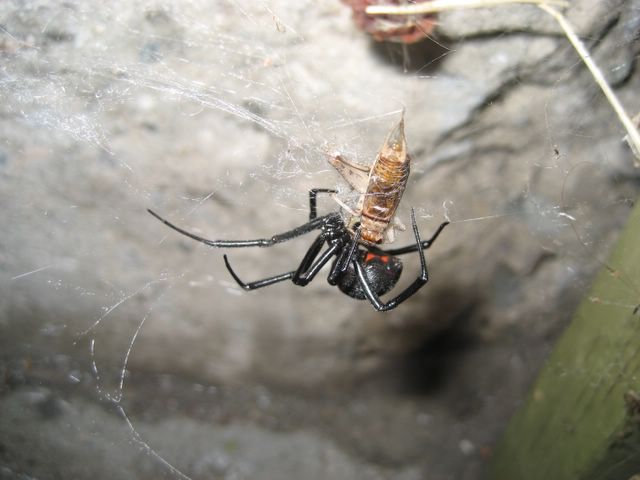
The spider continued to wrap the prey for a bit before dragging it off to the retreat behind that green piece of wood.
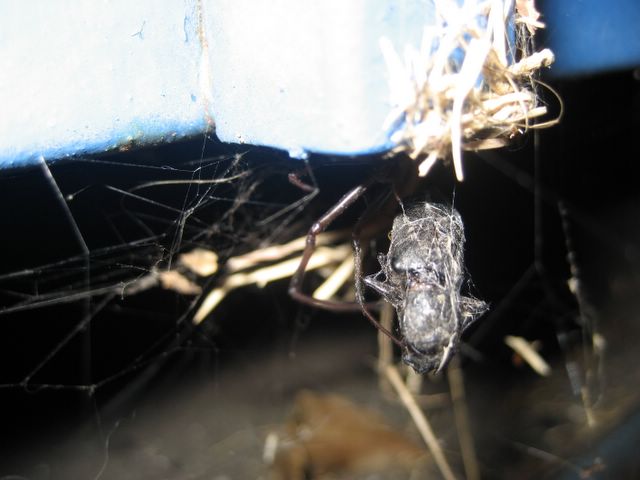
Black widows will sit openly in their webs until they catch something, but will then make their way to their retreat to eat. This is a rather chilling shot. Black widow 1, beetle 0.

Here's an immature female. I was trying to get a good closeup, but I accidentally knocked her out of the web with the camera, and I got this shot before she scurried off.

I'm proud of this one, but I wish it had turned out better. This was the first time I had ever seen a male black widow live. He's in the web of an adult female, but she scurried away as I was trying to shoot the two of them together. The male was deep in the web behind a whole bunch of tripwires, so I couldn't get a close-up shot--but if you click to see the larger version, you can clearly see the embolus on the palps.

Here's a nice closeup of an L. hesperus with just about the most perfect hourglass you'll ever see. This required a little bit of caution.

I'm perhaps proudest of this shot. These things can definitely be intimidating.
That concludes this week's special edition photoessay. I'll resume with a regularly scheduled spider next week!


